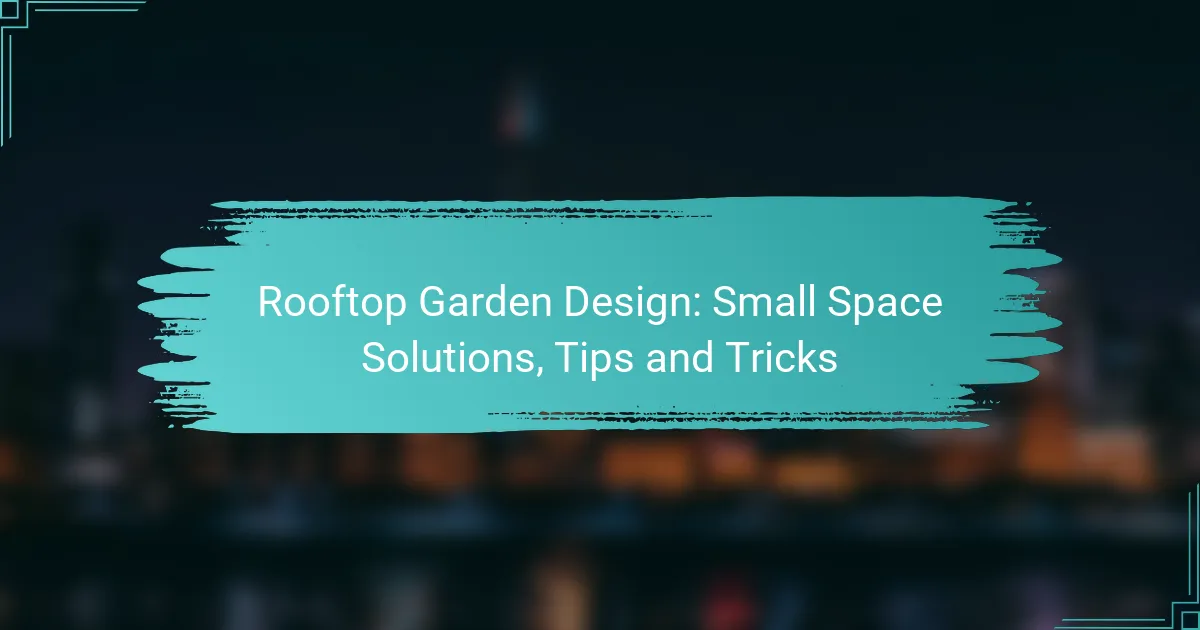Creating a rooftop garden in a small space can be both rewarding and challenging, but with the right design solutions, you can maximize your area while enhancing its beauty. Techniques such as vertical gardening, container gardening, and hydroponics allow for a diverse range of plants without needing extensive ground space. By selecting compact and resilient plants and utilizing multi-functional furniture, you can transform your rooftop into a vibrant oasis that thrives in limited conditions.
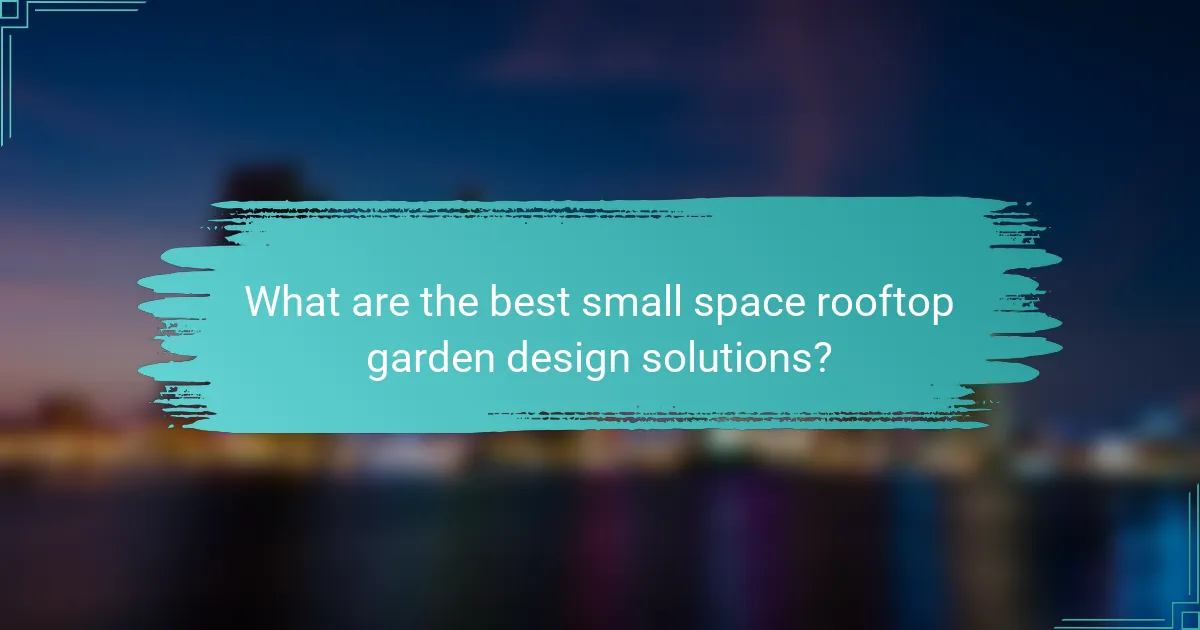
What are the best small space rooftop garden design solutions?
The best small space rooftop garden design solutions focus on maximizing limited areas while ensuring functionality and aesthetics. Techniques like vertical gardening, container gardening, and hydroponics allow for diverse plant growth without requiring extensive ground space.
Vertical gardening systems
Vertical gardening systems utilize wall-mounted structures or trellises to grow plants upward, making efficient use of vertical space. These systems can include pocket planters, wall grids, or modular panels that support climbing plants and herbs.
When designing a vertical garden, consider the weight of the plants and soil, ensuring your rooftop can support the load. Choose plants that thrive in vertical settings, such as peas, tomatoes, or ornamental vines, to enhance both beauty and productivity.
Container gardening options
Container gardening involves using pots, raised beds, or other vessels to grow plants, making it a flexible option for small rooftop spaces. Containers come in various sizes and materials, allowing for customization based on your available area and aesthetic preferences.
To optimize container gardening, select lightweight materials like fiberglass or resin, and ensure proper drainage. Group containers together to create a lush look while maximizing sunlight exposure for your plants.
Modular planting designs
Modular planting designs consist of pre-fabricated units that can be arranged in different configurations, offering versatility in small spaces. These units often include built-in irrigation systems and can be easily rearranged as needed.
When implementing modular designs, consider how the arrangement affects sunlight and airflow. Choose a mix of plants to create visual interest and ensure that each module has adequate access to water and nutrients.
Hydroponic setups
Hydroponic setups grow plants in nutrient-rich water rather than soil, making them ideal for rooftop gardens with limited space. These systems can be compact and efficient, allowing for year-round gardening regardless of weather conditions.
When setting up a hydroponic system, choose a method that suits your skill level, such as deep water culture or nutrient film technique. Regularly monitor nutrient levels and pH to ensure optimal plant growth.
Green roofs
Green roofs involve planting vegetation directly on the rooftop surface, creating a living layer that can improve insulation and reduce stormwater runoff. This method requires a proper waterproofing system and a lightweight growing medium to support plant life.
For a successful green roof, select drought-resistant plants that can thrive in your climate. Consult local regulations regarding green roof installations, as some areas may have specific guidelines or incentives for green infrastructure projects.

How can I maximize space in my rooftop garden?
To maximize space in your rooftop garden, utilize vertical gardening techniques, multi-functional furniture, and creative planter placements. These strategies help you make the most of limited areas while enhancing the garden’s aesthetic and functionality.
Layered planting techniques
Layered planting involves using different heights and depths to create a visually appealing and efficient garden space. Consider using tiered planters or vertical wall gardens to maximize your planting area without taking up too much floor space.
Incorporate plants of varying sizes, such as tall grasses or climbing vines alongside shorter flowers or herbs. This not only optimizes space but also creates a lush, dynamic environment that can thrive in small areas.
Multi-functional furniture
Choosing multi-functional furniture can significantly enhance the usability of your rooftop garden. Look for benches that double as storage for gardening tools or tables that can fold away when not in use.
Consider using ottomans that can serve as seating and storage for cushions or gardening supplies. This approach allows you to maintain a clean and organized space while providing necessary amenities.
Use of railings for planters
Utilizing railings for planters is an effective way to add greenery without sacrificing floor space. Attach planters directly to the railing to create a vibrant border that enhances privacy and aesthetics.
Choose lightweight, weather-resistant materials for your railing planters to ensure durability. Ensure proper drainage to prevent water accumulation, which can damage both the plants and the railing structure.
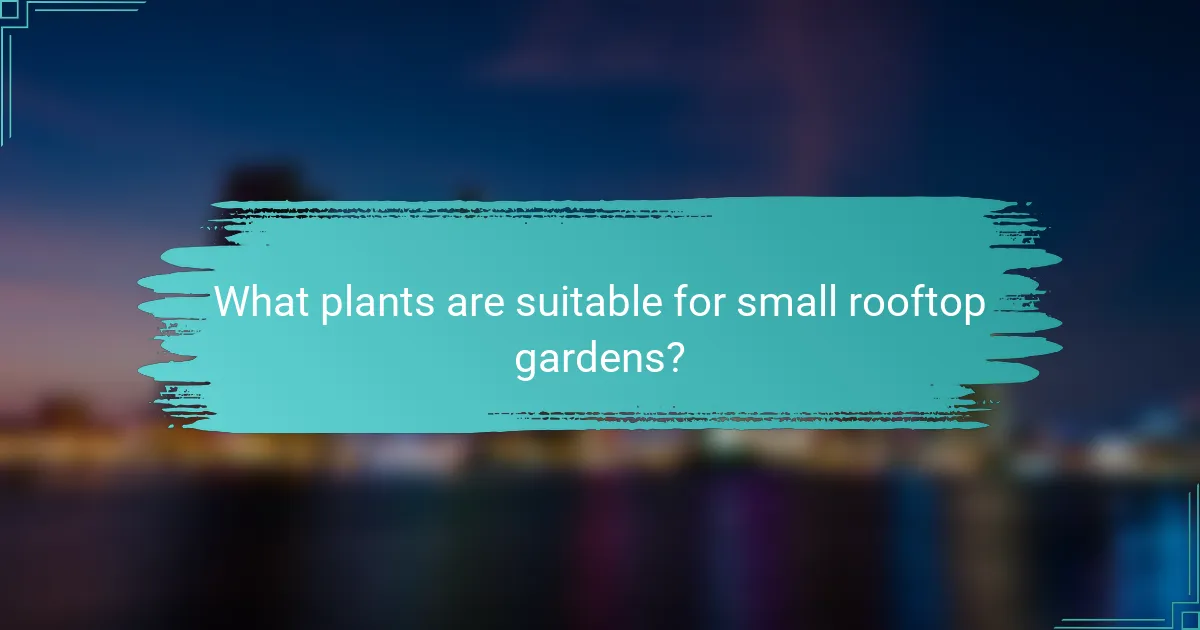
What plants are suitable for small rooftop gardens?
Small rooftop gardens can thrive with the right selection of plants that are compact, resilient, and suited for limited space. Consider options that require minimal soil depth and can withstand varying weather conditions.
Succulents and cacti
Succulents and cacti are ideal for small rooftop gardens due to their low maintenance and drought-resistant qualities. They thrive in well-drained soil and can tolerate direct sunlight, making them perfect for sunny rooftops.
When selecting succulents, look for varieties like Echeveria, Sedum, and Aloe. These plants can be arranged in creative ways, such as in vertical gardens or decorative pots, adding visual interest without taking up much space.
Herbs for urban gardening
Herbs are a fantastic choice for small rooftop gardens, providing both culinary benefits and greenery. Popular options include basil, thyme, rosemary, and mint, which can be grown in small containers or window boxes.
Consider grouping herbs by their sunlight needs and watering requirements to simplify care. Regular harvesting encourages growth, so trim them often to enjoy fresh flavors in your meals.
Small fruit trees
Small fruit trees, such as dwarf varieties of apple, peach, or citrus, can be successfully grown in rooftop gardens. These trees typically require larger pots and adequate sunlight but can produce fruit in limited space.
Choose varieties that are bred for container growth and ensure they receive proper care, including regular watering and fertilization. Keep in mind that some fruit trees may require pollination, so consider planting more than one variety for better yields.
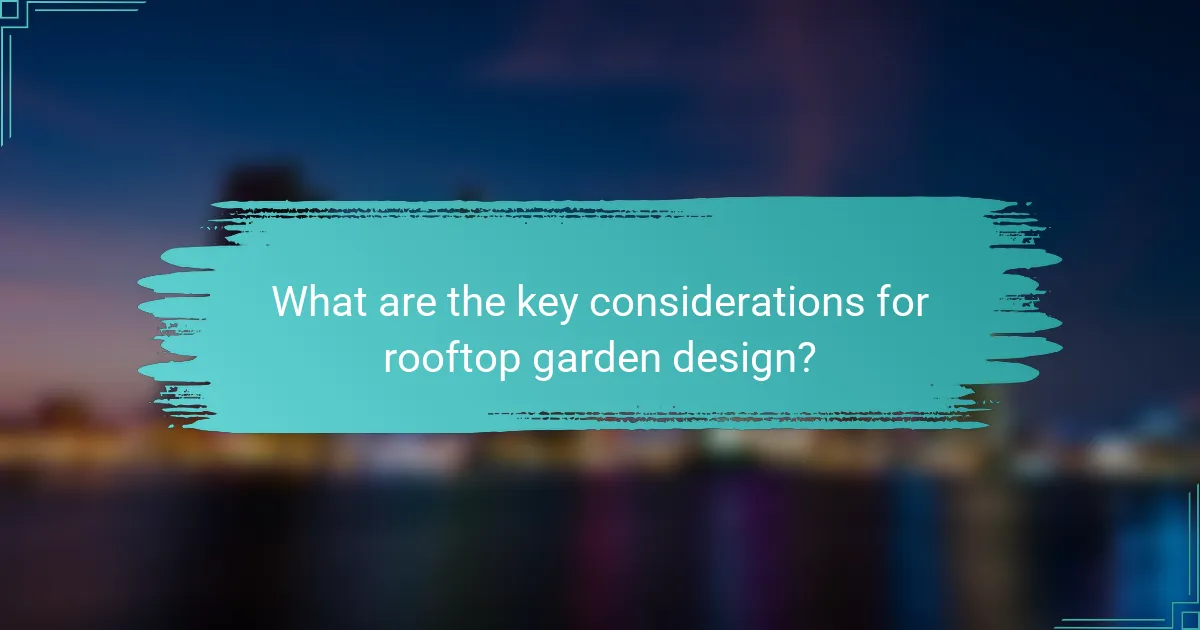
What are the key considerations for rooftop garden design?
When designing a rooftop garden, it’s essential to consider weight limitations, sunlight exposure, and water drainage solutions. These factors will significantly impact the feasibility and success of your garden project.
Weight limitations
Weight limitations are critical in rooftop garden design, as most rooftops can only support a specific load. Typically, this load includes the weight of soil, plants, and any additional structures like furniture or pathways.
To ensure safety and compliance, consult with a structural engineer to determine the maximum weight your rooftop can bear. Generally, a well-planned rooftop garden should aim for a total weight of around 15-20 kg per square meter, including all elements.
Sunlight exposure
Sunlight exposure is vital for plant growth and should be assessed before planting. Most plants require at least six hours of direct sunlight daily, so observe your rooftop’s sun patterns throughout the day.
Consider the orientation of your rooftop. South-facing roofs typically receive the most sunlight, while north-facing ones may be shadier. Choose plants that thrive in your specific light conditions, and use reflective materials to maximize light if needed.
Water drainage solutions
Effective water drainage solutions are essential to prevent water accumulation, which can damage your rooftop and plants. Ensure that your garden design includes a proper drainage system, such as gravel layers or drainage mats, to facilitate water flow.
Incorporate containers with drainage holes or raised beds to promote efficient water management. Regularly check for blockages in drainage systems to maintain optimal conditions and avoid water-related issues.
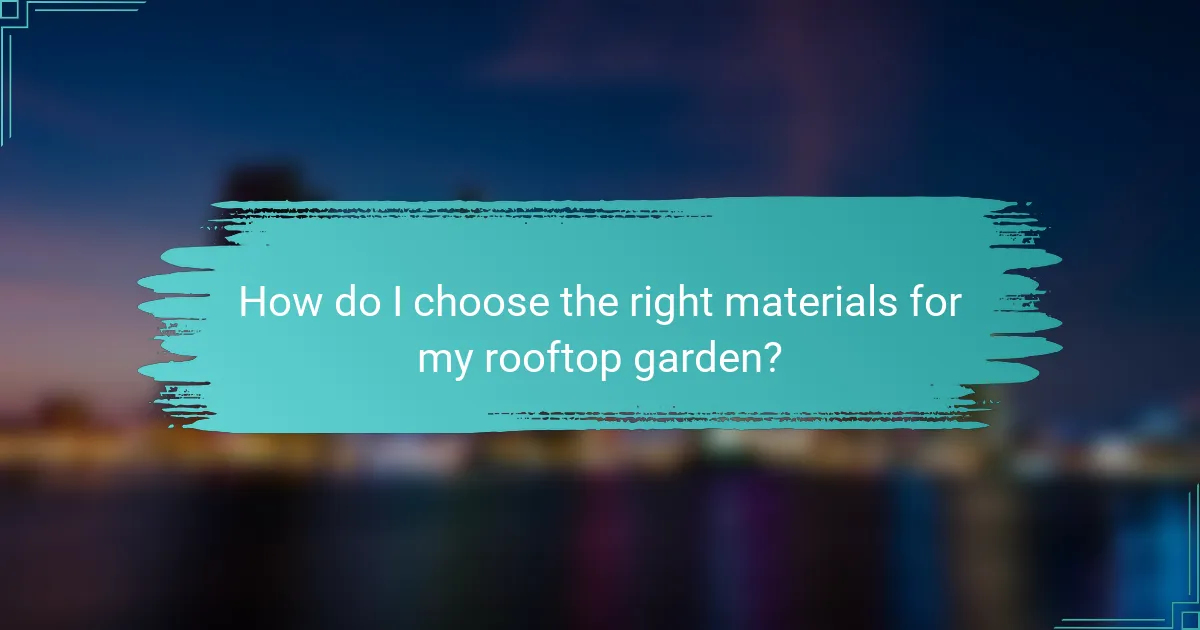
How do I choose the right materials for my rooftop garden?
Choosing the right materials for your rooftop garden is essential for ensuring durability, aesthetics, and plant health. Consider factors such as weight, drainage, and climate compatibility when selecting materials.
Weight considerations
When designing a rooftop garden, weight is a crucial factor. Most rooftops can support a limited load, so opt for lightweight materials like modular planters or soil alternatives such as coconut coir. Aim for a total weight, including plants and soil, that stays within the structural limits of your building.
Drainage solutions
Effective drainage is vital to prevent water accumulation, which can damage both plants and the building structure. Use materials like perforated pots or raised beds with drainage holes. Incorporating a layer of gravel or a drainage mat can further enhance water flow and protect your rooftop.
Climate compatibility
Select materials that can withstand local weather conditions. For instance, if you live in a region with high temperatures, choose UV-resistant pots and heat-tolerant plants. In colder climates, consider insulating materials to protect roots from freezing temperatures.
Plant selection
Choose plants that thrive in rooftop environments, which often experience wind and direct sunlight. Native plants or drought-resistant varieties can be excellent choices, as they typically require less maintenance and water. Group plants with similar water and light needs to simplify care.
Maintenance requirements
Consider the maintenance needs of your materials and plants. Opt for durable materials that require minimal upkeep, such as metal or treated wood for planters. Regularly check for drainage issues and ensure that plants are pruned and watered according to their specific needs.
